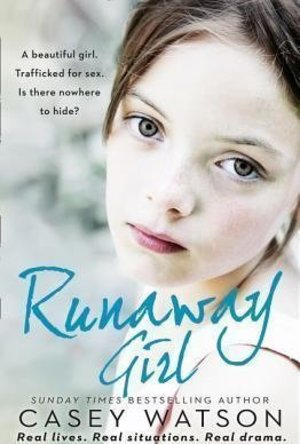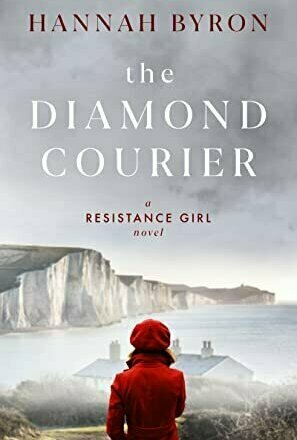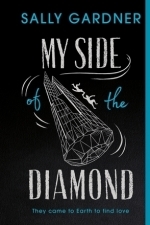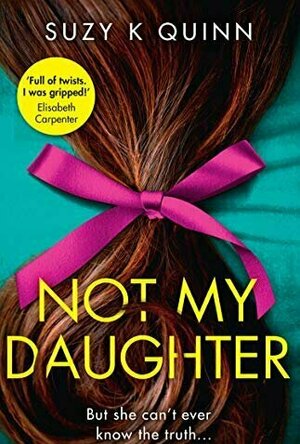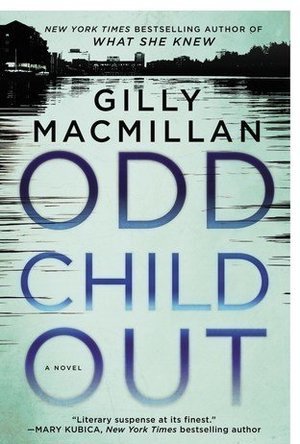Search

Nothing is Sacrosanct: No One Can Hide from Their Sins Forever
Book
Nothing is Sacrosanct: Intense, Raw Novel Takes Calculated Revenge on Child Abuse Aggressors;...

From the Fatherland with Love
Ryu Murakami, Charles De Wolf, Ralph McCarthy and Ginny Takemori
Book
An ambitious, epic dystopian novel - part political thriller and part satire. From the Fatherland,...
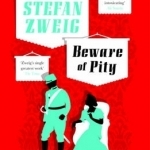
Beware of Pity
Anthea Bell, Stefan Zweig and David Pearson
Book
Stefan's Zweig's Beware of Pity is an almost unbearably tense and powerful tale of unrequited love...
Hazel (1853 KP) rated Runaway Girl: A beautiful girl. Trafficked for sex. Is there nowhere to hide? in Books
Dec 14, 2018
<i>I received this book for free through Goodreads First Reads.</i>
Casey Watson is a specialist foster carer who temporarily houses vulnerable children in emergency situations. Since working in this field for decades, she has been documenting her experiences in a series of books, each one focusing on a different child. Her thirteenth, and most recent book is <i>Runaway Girl</i>, aptly named about a (supposedly) fourteen-year-old girl, running away from several distressing situations.
Adrianna arrives on Casey’s doorstep with no possessions, no English and no passport. Apart from knowing she is Polish, Adrianna is a complete mystery to the Watson family and the services involved. With her sixth sense tingling, Casey is certain there is something important that Adrianna is hiding and, despite all her attempts, it is not until an emergency hospitalization that the frightened Polish girl starts telling the truth.
With a background of abuse, homelessness and sex trafficking, Adrianna’s story will open readers’ eyes to the shocking situations many foreign children find themselves. Unfortunately, Adrianna is only one out of 5,000 girls in the last decade and a half to be brought to England illegally and forced into prostitution.
Fortunately, Adrianna is lucky to have escaped and found a safe place to stay in the Watson household. Without Casey’s care and determination to provide a future for her, Adrianna would have remained one of the “hidden children” that arrive in England every year.
Casey writes in a novel-like format, describing Adrianna’s circumstances from a carer’s point of view. Slowly revealing the secrets of Adrianna’s past, Casey keeps the reader interested in the same way a fiction author would with a clever plot line. Emphasising the difficulties Adrianna has, not only coming to terms with the abuse she has faced, but also worrying about whether authorities will allow her to remain in England, Casey appeals to the readers’ emotions, making it clear that, although here illegally, trafficked children have every right to be protected and looked after by British authorities.
Although Casey writes under a pseudonym, and assumedly alters all names within the book, it is not certain how much of the storyline is true, or whether the situation has been accentuated in order to capture the reader’s attention. This, however, is not important – people will read this for entertainment, therefore the accuracy of the content is not as significant as the way in which it is told. <i>Runaway Girl</i>, whilst shocking, is engaging and easy to read, with a satisfying ending.
<i>Runaway Girl</i> is the only book I have read from Casey Watson, yet I can tell she is a worthy and successful author. Her stories – at least the blurbs – seem similar to other authors, such as Torey Hayden, who also write about their experiences helping vulnerable children. Casey Watson’s book need not be read in any particular order; therefore <i>Runaway Girl</i> is as good a place as any to begin.
Casey Watson is a specialist foster carer who temporarily houses vulnerable children in emergency situations. Since working in this field for decades, she has been documenting her experiences in a series of books, each one focusing on a different child. Her thirteenth, and most recent book is <i>Runaway Girl</i>, aptly named about a (supposedly) fourteen-year-old girl, running away from several distressing situations.
Adrianna arrives on Casey’s doorstep with no possessions, no English and no passport. Apart from knowing she is Polish, Adrianna is a complete mystery to the Watson family and the services involved. With her sixth sense tingling, Casey is certain there is something important that Adrianna is hiding and, despite all her attempts, it is not until an emergency hospitalization that the frightened Polish girl starts telling the truth.
With a background of abuse, homelessness and sex trafficking, Adrianna’s story will open readers’ eyes to the shocking situations many foreign children find themselves. Unfortunately, Adrianna is only one out of 5,000 girls in the last decade and a half to be brought to England illegally and forced into prostitution.
Fortunately, Adrianna is lucky to have escaped and found a safe place to stay in the Watson household. Without Casey’s care and determination to provide a future for her, Adrianna would have remained one of the “hidden children” that arrive in England every year.
Casey writes in a novel-like format, describing Adrianna’s circumstances from a carer’s point of view. Slowly revealing the secrets of Adrianna’s past, Casey keeps the reader interested in the same way a fiction author would with a clever plot line. Emphasising the difficulties Adrianna has, not only coming to terms with the abuse she has faced, but also worrying about whether authorities will allow her to remain in England, Casey appeals to the readers’ emotions, making it clear that, although here illegally, trafficked children have every right to be protected and looked after by British authorities.
Although Casey writes under a pseudonym, and assumedly alters all names within the book, it is not certain how much of the storyline is true, or whether the situation has been accentuated in order to capture the reader’s attention. This, however, is not important – people will read this for entertainment, therefore the accuracy of the content is not as significant as the way in which it is told. <i>Runaway Girl</i>, whilst shocking, is engaging and easy to read, with a satisfying ending.
<i>Runaway Girl</i> is the only book I have read from Casey Watson, yet I can tell she is a worthy and successful author. Her stories – at least the blurbs – seem similar to other authors, such as Torey Hayden, who also write about their experiences helping vulnerable children. Casey Watson’s book need not be read in any particular order; therefore <i>Runaway Girl</i> is as good a place as any to begin.
Hazel (1853 KP) rated The Followers in Books
Dec 17, 2018
My rating: 3.5
<i>I received this book for free through Goodreads First Reads.
The Followers</i> is the compelling second novel of the British author Rebecca Wait. Stephanie is living a mundane life with her daughter, making what little money she can at a local coffee shop. But then she meets Nathaniel, a man who says he wants to love her, look after her and make her happy. Stephanie and Judith move in with Nathaniel at a place known as the Ark, with a bunch of other people who are part of a religious cult. Nathaniel, who proclaims himself as a prophet, is determined for Stephanie to forget about her past and turn herself to God. Judith, however, is not so easy to persuade. However a turn of events raise questions as to whether Nathaniel should really be trusted.
The story begins with Stephanie in prison where she is serving her sentence for a crime the reader has no knowledge of. It then switches between “before” and “after” with “before” being when Stephanie meets Nathaniel and “after” involving the prison scenes. From the very start the reader knows something bad is going to happen, that Stephanie is going to break a law bad enough for her to be imprisoned. The following chapters keep readers guessing what exactly that offence would be.
The novel gets darker and darker as the truth about the running of the Ark is revealed. With violence and punishments being doled out, Nathaniel is no longer the man he originally appeared. As the book climaxes it is shocking when the reader realizes what it is that Stephanie is going to do.
As well as Judith there are other children living in the Ark, but the difference is they were born there and have known nothing else except doing things in the name of God. Judith on the other hand was not sheltered from the “evils” of the outside world and thus has a different opinion about the way Nathaniel treats his followers. As it turns out, Judith is right to distrust the ways of this man, but there is nothing she can do about her situation.
Although containing a strong religious theme, <i>The Followers</i> is not a piece of Christian fiction. The behaviour of Nathaniel and the members of the Ark does not reflect the average Christian, and everyone, whether religious or not, will be shocked by the happenings in this book.
It took a while to get into the storyline and the first few chapters did not feel particularly well written, however readers will quickly be sucked into the plot and will want to keep reading to find out what happens. <i>The Followers</i> is not a happy story and there are a few sad and distressing scenes, which make the reader really feel for some of the characters. Overall it is a very interesting read.
<i>I received this book for free through Goodreads First Reads.
The Followers</i> is the compelling second novel of the British author Rebecca Wait. Stephanie is living a mundane life with her daughter, making what little money she can at a local coffee shop. But then she meets Nathaniel, a man who says he wants to love her, look after her and make her happy. Stephanie and Judith move in with Nathaniel at a place known as the Ark, with a bunch of other people who are part of a religious cult. Nathaniel, who proclaims himself as a prophet, is determined for Stephanie to forget about her past and turn herself to God. Judith, however, is not so easy to persuade. However a turn of events raise questions as to whether Nathaniel should really be trusted.
The story begins with Stephanie in prison where she is serving her sentence for a crime the reader has no knowledge of. It then switches between “before” and “after” with “before” being when Stephanie meets Nathaniel and “after” involving the prison scenes. From the very start the reader knows something bad is going to happen, that Stephanie is going to break a law bad enough for her to be imprisoned. The following chapters keep readers guessing what exactly that offence would be.
The novel gets darker and darker as the truth about the running of the Ark is revealed. With violence and punishments being doled out, Nathaniel is no longer the man he originally appeared. As the book climaxes it is shocking when the reader realizes what it is that Stephanie is going to do.
As well as Judith there are other children living in the Ark, but the difference is they were born there and have known nothing else except doing things in the name of God. Judith on the other hand was not sheltered from the “evils” of the outside world and thus has a different opinion about the way Nathaniel treats his followers. As it turns out, Judith is right to distrust the ways of this man, but there is nothing she can do about her situation.
Although containing a strong religious theme, <i>The Followers</i> is not a piece of Christian fiction. The behaviour of Nathaniel and the members of the Ark does not reflect the average Christian, and everyone, whether religious or not, will be shocked by the happenings in this book.
It took a while to get into the storyline and the first few chapters did not feel particularly well written, however readers will quickly be sucked into the plot and will want to keep reading to find out what happens. <i>The Followers</i> is not a happy story and there are a few sad and distressing scenes, which make the reader really feel for some of the characters. Overall it is a very interesting read.
BookInspector (124 KP) rated Leopard at the Door in Books
Sep 24, 2020
More reviews at https://bbookinspector.wordpress.com
My favourite genre to read normally is mystery, crime or thrillers, but I try to choose different genres from time to time. I need to rest from investigations and murders, that’s where historical fiction, YA and other books come in. This book is no exception; I needed something to clear my mind, and it really done the job.
Let me begin by saying, that I loved the environment used in this book. Author portrayed the surroundings and places in this book with great detail, and made me actually feel the African spirit. So, all her travels through Africa, really helped her to describe what she felt to the reader.
The main character in this book was Rachel, and she was the one to share her life with a reader. This novel had a huge variety of very diverse characters, some of them positive and dear to the heart, and some of them really negative, which made me really angry about them. Unfortunately, I did not have any favourite character in this book, as I felt they were not fully developed and opened up to the reader. I would’ve liked to read different perspectives and have more insight into different personalities. Even though I really tried to like Rachel’s rebellious views and kind heart, I think some of her decisions were really silly and disappointing.
The narrative of this novel starts in 1952, when British Empire is on a verge of collapsing, and Kenya wishes its independence. I absolutely adored all the details about Mau Mau, their ideology and ways of action. I loved Michael’s thoughts about war and his country’s independence. I think, this book was really well researched and the whole spirit of the book was shared just gorgeously. The whole story was flowing very smoothly, with some turns and twists, which kept me interested. There was a great love story going on in this book, but I would’ve liked it to be a bit more passionate than it was. Author discussed some interesting topics in this book, such as: Life after mother’s death and relationship with a stepmother; feelings, when you don’t have anyone to turn to; love and betrayal.
The writing style of this novel was not difficult to read, but it contains some African words, which were explained at the end of the book. (If you read it on Kindle, it’s not very helpful) The chapters of this book have decent length, but it might drag a little, because there is not much action going on in this novel. The ending was quite interesting and done the justice to the book and Rachel, but still left me questioning about “What happened to Michael?” So, overall, I actually enjoyed this story of wish for independence, unexpected love, family difficulties and betrayal, and I would recommend immersing yourself into this beautiful Kenyan setting.
Was given this book by publisher and NetGalley for honest review.
My favourite genre to read normally is mystery, crime or thrillers, but I try to choose different genres from time to time. I need to rest from investigations and murders, that’s where historical fiction, YA and other books come in. This book is no exception; I needed something to clear my mind, and it really done the job.
Let me begin by saying, that I loved the environment used in this book. Author portrayed the surroundings and places in this book with great detail, and made me actually feel the African spirit. So, all her travels through Africa, really helped her to describe what she felt to the reader.
The main character in this book was Rachel, and she was the one to share her life with a reader. This novel had a huge variety of very diverse characters, some of them positive and dear to the heart, and some of them really negative, which made me really angry about them. Unfortunately, I did not have any favourite character in this book, as I felt they were not fully developed and opened up to the reader. I would’ve liked to read different perspectives and have more insight into different personalities. Even though I really tried to like Rachel’s rebellious views and kind heart, I think some of her decisions were really silly and disappointing.
The narrative of this novel starts in 1952, when British Empire is on a verge of collapsing, and Kenya wishes its independence. I absolutely adored all the details about Mau Mau, their ideology and ways of action. I loved Michael’s thoughts about war and his country’s independence. I think, this book was really well researched and the whole spirit of the book was shared just gorgeously. The whole story was flowing very smoothly, with some turns and twists, which kept me interested. There was a great love story going on in this book, but I would’ve liked it to be a bit more passionate than it was. Author discussed some interesting topics in this book, such as: Life after mother’s death and relationship with a stepmother; feelings, when you don’t have anyone to turn to; love and betrayal.
The writing style of this novel was not difficult to read, but it contains some African words, which were explained at the end of the book. (If you read it on Kindle, it’s not very helpful) The chapters of this book have decent length, but it might drag a little, because there is not much action going on in this novel. The ending was quite interesting and done the justice to the book and Rachel, but still left me questioning about “What happened to Michael?” So, overall, I actually enjoyed this story of wish for independence, unexpected love, family difficulties and betrayal, and I would recommend immersing yourself into this beautiful Kenyan setting.
Was given this book by publisher and NetGalley for honest review.
Hazel (1853 KP) rated The Diamond Courier in Books
Dec 10, 2020
Twenty years have passed since the end of Hannah Byron's World War One novel In Picardy's Fields. It is now 1939 and the Second World War is just beginning, but all seems peaceful in Kent, England where the narrator, Lili Hamilton, lives with her parents. War is the last thing on Lili's mind as she contemplates how to get out of an arranged marriage and pursue a career in journalism.
The surname Hamilton may be familiar to those who have read the previous book but Lady Madeleine has left her war achievements far behind in The Diamond Courier where she plays the role of a prim and proper lady of the house. Her daughter, Liliane, feels trapped by her sensible parents' expectations who thwart her plans to be a political journalist. Yet Lili, encouraged by the handsome leader of the British Communist Party Leo Oppenheim, perseveres, thus estranging herself from her family.
Lili soon learns living in London with Leo is not the life she desired, but feels it is too late to back out, especially after witnessing the treatment of Jews on the continent. The Jewish community need someone to bring their precious diamonds to safety before the Germans get their hands on them, and they believe Lili is the best person for the job. Unless, of course, she gets caught.
The Diamond Courier is much darker than Byron's previous book. Naturally, war is not a happy topic, but the sense of hope felt in In Picardy's Fields is missing in this novel. The story divides into two sections, "Leo" and "After Leo". The former is lengthier, drawn-out, and not always pleasant to read. The latter, on the other hand, is packed with danger, excitement and adventure.
For Lili, Communism is something new and exciting, which she desires to pursue. The party has clear views about the war, with which all members must agree. Yet, when faced with the horrors of war, Lili realises she must cast aside her political opinions. Whether Communist, Jew, sympathiser or resistance member, no one deserves the terrible treatment delivered by the Nazis.
Although this is a work of fiction, Byron remains faithful to the true nature of the Second World War. She does not gloss over any of the atrocities and, whilst the reader keeps their fingers and toes crossed that Lili will get her "happily ever after" ending, this cannot be possible for everyone in the novel.
Aiming to show the strength of women living in a "man's world", Byron has created female characters of whom to be proud and respect. Whilst the storyline may not always be pleasant, it is a gripping narrative that immerses the reader into Lili's life and experiences. Hannah Byron has a way with words that keeps the reader engaged throughout. She is an author to keep an eye on.
The surname Hamilton may be familiar to those who have read the previous book but Lady Madeleine has left her war achievements far behind in The Diamond Courier where she plays the role of a prim and proper lady of the house. Her daughter, Liliane, feels trapped by her sensible parents' expectations who thwart her plans to be a political journalist. Yet Lili, encouraged by the handsome leader of the British Communist Party Leo Oppenheim, perseveres, thus estranging herself from her family.
Lili soon learns living in London with Leo is not the life she desired, but feels it is too late to back out, especially after witnessing the treatment of Jews on the continent. The Jewish community need someone to bring their precious diamonds to safety before the Germans get their hands on them, and they believe Lili is the best person for the job. Unless, of course, she gets caught.
The Diamond Courier is much darker than Byron's previous book. Naturally, war is not a happy topic, but the sense of hope felt in In Picardy's Fields is missing in this novel. The story divides into two sections, "Leo" and "After Leo". The former is lengthier, drawn-out, and not always pleasant to read. The latter, on the other hand, is packed with danger, excitement and adventure.
For Lili, Communism is something new and exciting, which she desires to pursue. The party has clear views about the war, with which all members must agree. Yet, when faced with the horrors of war, Lili realises she must cast aside her political opinions. Whether Communist, Jew, sympathiser or resistance member, no one deserves the terrible treatment delivered by the Nazis.
Although this is a work of fiction, Byron remains faithful to the true nature of the Second World War. She does not gloss over any of the atrocities and, whilst the reader keeps their fingers and toes crossed that Lili will get her "happily ever after" ending, this cannot be possible for everyone in the novel.
Aiming to show the strength of women living in a "man's world", Byron has created female characters of whom to be proud and respect. Whilst the storyline may not always be pleasant, it is a gripping narrative that immerses the reader into Lili's life and experiences. Hannah Byron has a way with words that keeps the reader engaged throughout. She is an author to keep an eye on.
Hazel (1853 KP) rated My Side of the Diamond in Books
Sep 16, 2017
Impassive
This ARC was provided by the publisher via NetGalley in exchange for an honest review
My Side of the Diamond is the latest novel by British author Sally Gardner. Employing the use of science fiction, Gardner explores the concept of love in a unique tale of a covered up alien invasion. The main characters are unfortunately caught up in the drama; however, no one will ever believe their story.
Jazmin Little’s best friend, Becky, has disappeared. Some say she was murdered, others claim she committed suicide, but what everyone agrees on is that she jumped from the top of the Shard in London, but never landed. Jazmin knows what happened but the authorities have torn her witness statement to shreds. Now everyone believes that she is the cause of Becky’s disappearance.
The reader plays an active role as the mysterious Mr. Jones who is interviewing a handful of characters involved with the mystery surrounding Becky’s fate. Jazmin and the others tell the reader, as Mr. Jones, the truth about the lead-up to the moment their lives changed forever. Jazmin explains the events that preceded Becky becoming infatuated with the enigmatic Icarus. From their first meeting, bizarre and frightening things began to occur. From Becky’s sudden recovery from anorexia as though she had just had an epiphany, to being chased by an impossible monster, the friends and their relatives are suddenly in serious danger.
Icarus claims to be an alien who has come to Earth to learn about love. Becky instantly believed him, however, Jazmin and the others remained sceptical. As they open up to Mr. Jones, they wish they could go back in time and change the way things panned out. In hindsight, they know who was good and who was bad, but at the time, it was impossible to know whom to trust.
Although the main story focuses on the relationship between Becky and Icarus and their resulting disappearance, Gardner also explores themes of social classes and friendship. Jazmin and Becky were polar opposite: Becky came from a family made of money, whereas Jazmin was lucky to have a can of baked beans for dinner. Despite this, they were best friends who did not let their backgrounds interfere with their relationship. The significance of their social class comes to light as Jazmin explains what happened at the trial after Becky’s disappearance. Being from such a low caste, it was easy for everyone to pin the blame on Jazmin.
The concept behind My Side of the Diamond is interesting, as is the method of narrating the story, however, it lacks any emotional connection. Mr. Jones, although having no dialogue of his own, comes across as an impassive character, and that is how I felt whilst reading the book. None of the characters were particularly relatable and it was difficult to care about what happened to them. Their circumstances were creepy, but also far-fetched and hard to comprehend.
Although Sally Gardner’s ideas are good, My Side of the Diamond is a disappointment, especially coming from a prize-winning author
My Side of the Diamond is the latest novel by British author Sally Gardner. Employing the use of science fiction, Gardner explores the concept of love in a unique tale of a covered up alien invasion. The main characters are unfortunately caught up in the drama; however, no one will ever believe their story.
Jazmin Little’s best friend, Becky, has disappeared. Some say she was murdered, others claim she committed suicide, but what everyone agrees on is that she jumped from the top of the Shard in London, but never landed. Jazmin knows what happened but the authorities have torn her witness statement to shreds. Now everyone believes that she is the cause of Becky’s disappearance.
The reader plays an active role as the mysterious Mr. Jones who is interviewing a handful of characters involved with the mystery surrounding Becky’s fate. Jazmin and the others tell the reader, as Mr. Jones, the truth about the lead-up to the moment their lives changed forever. Jazmin explains the events that preceded Becky becoming infatuated with the enigmatic Icarus. From their first meeting, bizarre and frightening things began to occur. From Becky’s sudden recovery from anorexia as though she had just had an epiphany, to being chased by an impossible monster, the friends and their relatives are suddenly in serious danger.
Icarus claims to be an alien who has come to Earth to learn about love. Becky instantly believed him, however, Jazmin and the others remained sceptical. As they open up to Mr. Jones, they wish they could go back in time and change the way things panned out. In hindsight, they know who was good and who was bad, but at the time, it was impossible to know whom to trust.
Although the main story focuses on the relationship between Becky and Icarus and their resulting disappearance, Gardner also explores themes of social classes and friendship. Jazmin and Becky were polar opposite: Becky came from a family made of money, whereas Jazmin was lucky to have a can of baked beans for dinner. Despite this, they were best friends who did not let their backgrounds interfere with their relationship. The significance of their social class comes to light as Jazmin explains what happened at the trial after Becky’s disappearance. Being from such a low caste, it was easy for everyone to pin the blame on Jazmin.
The concept behind My Side of the Diamond is interesting, as is the method of narrating the story, however, it lacks any emotional connection. Mr. Jones, although having no dialogue of his own, comes across as an impassive character, and that is how I felt whilst reading the book. None of the characters were particularly relatable and it was difficult to care about what happened to them. Their circumstances were creepy, but also far-fetched and hard to comprehend.
Although Sally Gardner’s ideas are good, My Side of the Diamond is a disappointment, especially coming from a prize-winning author
Ivana A. | Diary of Difference (1171 KP) rated Not My Daughter in Books
Oct 5, 2020
I am so happy to have the opportunity to be part of the blog tour for Not My Daughter by Suzy K. Quinn. Thank you to the team at HQ, for sending me an e-copy in exchange for an honest review. Have a look at the Blog Tour Banner below and check out the other bloggers.
Suzy K Quinn is a British fiction author, and writes in three different genres: psychological thriller, comedy and romance. She was first published by Hachette in 2010 with her debut novel Glass Geishas (now Night Girls), then self-published a romance series, the Ivy Lessons, which became an international bestseller and a #1 Kindle romance bestseller in the US and UK.
After her second daughter was born in 2013, she self-published the Bad Mother’s Diary series, which also went on to become a #1 Kindle romantic comedy bestseller. Suzy K Quinn’s novels have been translated into 7 languages and her books have sold over ¾ million copies worldwide.
She lives in Wivenhoe, Essex, with her husband Demi and two daughters, and travels to Mexico every year to write and study Mayan story telling. Suzy loves her family, friends and readers, but when pushed to add more to the list, she also loves travelling, food and alcohol.
Synopsis:
Lorna has been trying to protect her daughter Liberty for sixteen years. There are dark secrets from her past about her father that Lorna wishes her daughter never finds out. Liberty’s father is a monster, and the best solution is to hide. Forever.
But Liberty has other plans. One day, Liberty decides to find her father, no matter the cost. And Lorna can’t protect her if she doesn’t know where she went…
My Thoughts:
I really enjoyed Not My Daughter. It was a novel that kept me on my toes throughout the whole book and I was eager to know what happens in the end and who the true villain is.
We begin the story in one way, where we have an idea of who the bad person is, and how Lorna is the protector. But once we start reading more, this story becomes more twisted, and we don’t know who to trust anymore. This is something I see in books quite often, but it is not usually as well-written. Suzy did an amazing job writing this part, and making us switch sides as she wanted us to.
The ending was not predictable at all, although, it was a bit unrealistic. However, it really fit nicely with the whole story and I cannot be disappointed.
It is interesting to see how the mother-daughter relationship develops. But more so, how a relationship forms when a daughter wants to get to know her father, no matter what. You meet this person that you share genes with, and you want them to like you. You want them to accept you, like nothing happened. We could see this wish in Liberty as she meets her father – the need to be accepted as a daughter.
I would recommend this book to everyone that loves mystery thrillers. It is a one of a kind, and a very well-written one too.
Suzy K Quinn is a British fiction author, and writes in three different genres: psychological thriller, comedy and romance. She was first published by Hachette in 2010 with her debut novel Glass Geishas (now Night Girls), then self-published a romance series, the Ivy Lessons, which became an international bestseller and a #1 Kindle romance bestseller in the US and UK.
After her second daughter was born in 2013, she self-published the Bad Mother’s Diary series, which also went on to become a #1 Kindle romantic comedy bestseller. Suzy K Quinn’s novels have been translated into 7 languages and her books have sold over ¾ million copies worldwide.
She lives in Wivenhoe, Essex, with her husband Demi and two daughters, and travels to Mexico every year to write and study Mayan story telling. Suzy loves her family, friends and readers, but when pushed to add more to the list, she also loves travelling, food and alcohol.
Synopsis:
Lorna has been trying to protect her daughter Liberty for sixteen years. There are dark secrets from her past about her father that Lorna wishes her daughter never finds out. Liberty’s father is a monster, and the best solution is to hide. Forever.
But Liberty has other plans. One day, Liberty decides to find her father, no matter the cost. And Lorna can’t protect her if she doesn’t know where she went…
My Thoughts:
I really enjoyed Not My Daughter. It was a novel that kept me on my toes throughout the whole book and I was eager to know what happens in the end and who the true villain is.
We begin the story in one way, where we have an idea of who the bad person is, and how Lorna is the protector. But once we start reading more, this story becomes more twisted, and we don’t know who to trust anymore. This is something I see in books quite often, but it is not usually as well-written. Suzy did an amazing job writing this part, and making us switch sides as she wanted us to.
The ending was not predictable at all, although, it was a bit unrealistic. However, it really fit nicely with the whole story and I cannot be disappointed.
It is interesting to see how the mother-daughter relationship develops. But more so, how a relationship forms when a daughter wants to get to know her father, no matter what. You meet this person that you share genes with, and you want them to like you. You want them to accept you, like nothing happened. We could see this wish in Liberty as she meets her father – the need to be accepted as a daughter.
I would recommend this book to everyone that loves mystery thrillers. It is a one of a kind, and a very well-written one too.
Kristy H (1252 KP) rated Odd Child Out (Jim Clemo #2) in Books
Feb 13, 2018
The second book in [a:Gilly Macmillan|8183303|Gilly Macmillan|https://images.gr-assets.com/authors/1490347732p2/8183303.jpg]'s excellent DI Jim Clemo series finds Jim back in similar circumstances from the first--working against time to save a child. Jim has returned from leave after the Ben Finch case, and he's ready to redeem himself in the eyes DCI Fraser and his peers. He's assigned what looks to be a terrible accident: best pals Noah Sadler and Abdi Mahad are out late one evening when teenage Noah falls into a local canal, rendering him unconscious. Abdi refuses to speak about what happened, leaving the families (and police) to ponder what really occurred that evening. Complicating matters is the fact that Noah is already ill from cancer; plus Noah is British, while Abdi and his family are Somalian refugees, so Jim fears how this case will be presented in the press. By most accounts, Noah and Abdi are best friends, so what truly went down night?
<i>This is another gorgeous gem of a novel by Macmillan</i>, who offers yet one more beautifully-written mystery combined with lovely, perfectly drawn characters. This book touched me in so many ways, and <i>I just cannot keep raving enough about how well this author writes, or how she so excellently embodies her characters</i>. Again, this is no straightforward mystery, or simple fiction, but a wonderful combination of the two.
For me, this book really hit from home the beginning, as Jim mentions how an anti-immigration march by a neo-Nazi group has rocked Bristol, wrecking havoc on the police force, as well as emotions in the area. It's clear that racial tensions are high. As someone who was born in Charlottesville, VA, and lived in the suburbs of the area for the last nearly ten years, I felt this in my heart all too well. The backdrop of race stretches across the fabric of Macmillan's entire novel, and it's quite well done, in my opinion.
On one end, we have the Sadler family--well-off and British: Noah attends a posh private school, Fiona manages Noah and Noah's illness, and Ed is a photographer--often of refugees. In fact, we learn that he's even photographed the very camp where Abdi's parents and sister lived. The Sadler's life, however, is clouded by the tragedy of Noah's cancer, which has basically formed each family member into who they are today.
As for the Mahads, we see how their past experiences has created them, as well. <i>One of the strengths of this book is that we get small portions of narration from all of characters: the Sadlers, the Mahads, and Jim.</i> The bits and pieces you learn of the Mahad's origins--my goodness: it will break your heart. Macmillan captures the fear of the family because they are different due to the color of their skin and the country of their origin, yet you see their strength and pride shine across as well.
The main storyline of ODD CHILD OUT revolves around figuring out exactly what happened between the boys and how Noah ended up in the water. As mentioned, you get snippets from each character, as we slowly work up to that point of no return. We also get flashbacks to various pieces of earlier parts of their lives, and we start to realize that something has spooked the Mahad family--something is not as it seems. <i>It's not your conventional mystery, per se, but it's compelling and certainly intriguing.</i>
At its core, this is a heartbreaking book whose strength lies in its characters. It's a wonderful exploration on race and immigration and how difficult it is to be deemed "different" by our society. What I loved about this book, though, is that you could also wonder: is either family truly all that different at its core? Every parent will go to any length to protect their child, after all. I highly recommend picking this one up. It can be read as a stand-alone, but if you want more insight into Jim and his mindset, you should definitely read the first book, [b:What She Knew|25817531|What She Knew (Jim Clemo #1)|Gilly Macmillan|https://images.gr-assets.com/books/1441801604s/25817531.jpg|41344566], which is also excellent (my review <a href="https://www.goodreads.com/review/show/1421220730?comment=172068859#comment_form">here</a>;). I can't wait to see what Macmillan comes up with next! 4+ stars.
In a perfect swirl of ARC goodness, I received a copy of this novel from both Librarything and Edelweiss. A huge thanks to them and the publisher for a copy in return for an unbiased review. The book is available for purchase everywhere.
<center><a href="http://justacatandabookatherside.blogspot.com/">Blog</a>; ~ <a href="https://twitter.com/mwcmoto">Twitter</a>; ~ <a href="https://www.facebook.com/justacatandabook/">Facebook</a>; ~ <a href="https://plus.google.com/u/0/+KristyHamiltonbooks">Google+</a>; ~ <a href="https://www.instagram.com/justacatandabook/">Instagram</a>; </center>
<i>This is another gorgeous gem of a novel by Macmillan</i>, who offers yet one more beautifully-written mystery combined with lovely, perfectly drawn characters. This book touched me in so many ways, and <i>I just cannot keep raving enough about how well this author writes, or how she so excellently embodies her characters</i>. Again, this is no straightforward mystery, or simple fiction, but a wonderful combination of the two.
For me, this book really hit from home the beginning, as Jim mentions how an anti-immigration march by a neo-Nazi group has rocked Bristol, wrecking havoc on the police force, as well as emotions in the area. It's clear that racial tensions are high. As someone who was born in Charlottesville, VA, and lived in the suburbs of the area for the last nearly ten years, I felt this in my heart all too well. The backdrop of race stretches across the fabric of Macmillan's entire novel, and it's quite well done, in my opinion.
On one end, we have the Sadler family--well-off and British: Noah attends a posh private school, Fiona manages Noah and Noah's illness, and Ed is a photographer--often of refugees. In fact, we learn that he's even photographed the very camp where Abdi's parents and sister lived. The Sadler's life, however, is clouded by the tragedy of Noah's cancer, which has basically formed each family member into who they are today.
As for the Mahads, we see how their past experiences has created them, as well. <i>One of the strengths of this book is that we get small portions of narration from all of characters: the Sadlers, the Mahads, and Jim.</i> The bits and pieces you learn of the Mahad's origins--my goodness: it will break your heart. Macmillan captures the fear of the family because they are different due to the color of their skin and the country of their origin, yet you see their strength and pride shine across as well.
The main storyline of ODD CHILD OUT revolves around figuring out exactly what happened between the boys and how Noah ended up in the water. As mentioned, you get snippets from each character, as we slowly work up to that point of no return. We also get flashbacks to various pieces of earlier parts of their lives, and we start to realize that something has spooked the Mahad family--something is not as it seems. <i>It's not your conventional mystery, per se, but it's compelling and certainly intriguing.</i>
At its core, this is a heartbreaking book whose strength lies in its characters. It's a wonderful exploration on race and immigration and how difficult it is to be deemed "different" by our society. What I loved about this book, though, is that you could also wonder: is either family truly all that different at its core? Every parent will go to any length to protect their child, after all. I highly recommend picking this one up. It can be read as a stand-alone, but if you want more insight into Jim and his mindset, you should definitely read the first book, [b:What She Knew|25817531|What She Knew (Jim Clemo #1)|Gilly Macmillan|https://images.gr-assets.com/books/1441801604s/25817531.jpg|41344566], which is also excellent (my review <a href="https://www.goodreads.com/review/show/1421220730?comment=172068859#comment_form">here</a>;). I can't wait to see what Macmillan comes up with next! 4+ stars.
In a perfect swirl of ARC goodness, I received a copy of this novel from both Librarything and Edelweiss. A huge thanks to them and the publisher for a copy in return for an unbiased review. The book is available for purchase everywhere.
<center><a href="http://justacatandabookatherside.blogspot.com/">Blog</a>; ~ <a href="https://twitter.com/mwcmoto">Twitter</a>; ~ <a href="https://www.facebook.com/justacatandabook/">Facebook</a>; ~ <a href="https://plus.google.com/u/0/+KristyHamiltonbooks">Google+</a>; ~ <a href="https://www.instagram.com/justacatandabook/">Instagram</a>; </center>
